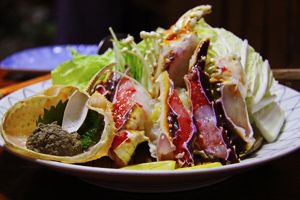How Much Does King Crab Cost?
Last Updated on January 20, 2024
Written by CPA Alec Pow | Content Reviewed by ![]() CFA Alexander Popinker
CFA Alexander Popinker
King crab is one of the most prized and expensive seafood delicacies in the world. But with king crab prices reaching over $50 per pound in high-end restaurants and markets, many consumers are left wondering – how did this crustacean become such a luxury item?
This article will break down the factors affecting the rising cost of king crab and provide expert insights into everything from current market trends to purchasing and cooking recommendations. Read on to learn why this succulent shellfish commands such a premium price and how sustainable fishing practices impact the supply.
Key Takeaways on King Crab Pricing
- Supply constraints like slow reproduction and small harvest quotas make king crab rarer than other seafood, resulting in high prices.
- Wild Alaskan king crab can cost $35-$60+ per pound in restaurants and markets. Prices have risen 50% in the past decade.
- Sustainability efforts are critical but also restrict supply, keeping king crab expensive.
- The delicate, sweet flavor and hearty portions make this prized shellfish worth the premium price for many seafood lovers.
- Consider purchasing frozen legs from retailers vs. restaurant dining to get the amazing taste of king crab at a lower price.
How Much Does King Crab Cost?
The short supply and high demand for king crab results in high prices, especially for large, fresh legs and claws wild-caught in Alaska. In fact, costs have risen over 50% in the past decade alone.
Today, wild king crab costs $35-$60 per pound on average in high-end seafood markets and restaurants. That’s over 4 times more expensive than smaller snow crab legs.
Experts cite the rising costs of fuel, transportation, storage, and labor in Alaska’s remote crab fisheries as key reasons for increasing wholesale and retail king crab prices in recent years. Environmental sustainability efforts that limit fishing also constrain supply levels.
While king crab prices fluctuate seasonally and regionally, the long-term trajectory points to this premium seafood continuing to command a luxury price tag for discerning consumers.
A-Z Animals notes that the retail king crab market prices are between $13 and $24 per kilogram or $5.90 to $10.88 per pound. Wholesale king crab market prices range from $9.10 to $16.8 per kilogram or $4.13 to $7.62 per pound.
Alaskan King Crab offers Red King Crab Legs for $356.00.
Crab Place sells Jumbo King Crab Legs for $79.99 per pound, and Colossal King Crab Legs for $649.99 for 10 lbs.
Farm-2-Market sells live Alaskan King Crab starting at $475.00 for 8 lbs.
FreshSeafood.com sells Jumbo Red King Crab Legs for a minimum purchase order of 2 pounds, with each crab leg between 1.25 to 1.5 pounds.
King Crab on Restaurant Menus vs Retail Markets
Since most king crab is frozen at sea, there is often minimal difference in taste and quality between thawed king crab legs served in restaurants versus sold in fish markets.
However, the preparation, overhead, and ambiance of fine dining establishments means that menu prices for king crab entrées are typically 60-100% higher than retail.
In top seafood restaurants, a 1/2 lb of king crab can cost $60-$120. The same quantity of frozen legs from a local fish market or online retailer may only cost $20-$40.
While special restaurant preparations may merit a moderate premium, keep in mind a lot of what you pay covers overhead, not just the seafood.
The Unique Flavor and Texture of King Crab
What makes people willing to pay so much for king crab legs and claws? These beasts deliver a unique taste and texture highly prized by seafood aficionados.
The largest species is the red king crab found in Alaska. Featuring a reddish-brown shell, white meat, and legs weighing up to 10 pounds each, red king crab has a delicate, sweet flavor. The meat has a moderately firm texture and flakes apart when cooked.
The smaller blue king crab offers a more pronounced sweetness and soft, almost creamy texture. Many chefs prefer blue king crab, but limited supply means it is rarely found outside Alaska.
Factors Influencing the Rising Price of King Crab
From breeding patterns to fishing regulations, many complex factors impact the limited supply of king crab – sending costs higher.
King crabs reproduce slowly, with females producing only thousands of eggs compared to millions for other crab species. They take 5-8 years to reach harvest size. These constraints limit population growth.
Meanwhile, cold Alaskan waters with treacherous weather mean king crab fishing is extremely labor-intensive and dangerous – with one of the highest fatality rates among commercial fisheries.
You might also like our articles about the cost of crab legs, lump crab meat, or Dungeness crab.
Strict fishing limits now prevent overharvesting of king crab. While critical for sustainability, reduced catch quantities also drive up demand and prices.
International export tariffs, seasonal closures during molting periods, and requirements for on-board processing facilities further restrict supply volumes.
No wonder exquisite king crab commands such an astronomical price!
Sustainability and King Crab Prices
 In the 1980s, overfishing led king crab populations to collapse, forcing fisheries to close.
In the 1980s, overfishing led king crab populations to collapse, forcing fisheries to close.
Today, strict quotas and best practice harvesting methods ensure the fishery and supply chain is completely sustainable. This allows king crab numbers to rebound while still meeting demand.
However, sustainable practices reduce supply volumes, increasing prices. Thankfully, consumers increasingly understand and appreciate the benefits of sustainably sourced seafood.
So while your king crab dinner may cost you a little more, you can enjoy it guilt-free knowing your purchase helps preserve king crab populations.
Chef Tips: Selecting and Cooking King Crab at Home
Check for freshness – Look for translucent, moist meat and avoid any with an ammonia-like odor. Legs should be packed tight in frozen sleeves.
Cook gently – Boil or steam legs for 7-10 minutes until the shell turns bright red. Overcooking makes the meat rubbery.
Pair wisely – Lemon, garlic butter, and white wine nicely complement the sweetness without overpowering the delicate flavor.
Use the claws – Don’t forget the tasty claw meat! Crack with a mallet or scissors.
Go beyond legs – The body meat is also delicious. Try it in pastas, salads, and crab cakes.
Consider sustainability – Ask your retailer about the king crab source and stay away from endangered fisheries.
Frequently Asked Questions
Why is king crab so expensive?
King crab prices are rising due to factors like slow reproduction, small catch quotas, remote fishing grounds, and on-board processing regulations. Limited supply and global demand for this prized delicacy keep costs high.
Is king crab rare?
It is not rare but king crab is limited in supply. Strict fishing limits prevent overharvesting, keeping populations sustainable. Their slow breeding and complex harvest operations restrict the catch quantities available each season.
Is king crab tasty?
King crab has an exquisite, sweet flavor that makes it one of the most desirable and expensive seafood types. The large legs offer hearty portions of tender, succulent meat. Alaskan red and blue king crab are considered the best-tasting varieties.
Final Words
So while king crab may be pricey, understanding why this luxurious delicacy commands such a premium sheds light on whether it’s worth splurging for your next special occasion.
With proper handling, cooking, and appreciation of its sustainability, king crab can be well worth the extra cost for seafood aficionados.

I wonder how old this article is… Albeit a good article, prices this year in 2022 are absolutely insane. I just bought red king crab legs last year in 2021 for $36 a pound. This year they are almost $60 a pound from global seafood, my normal “source“, and even the link above for Captain Jack… that greedy bastard wants over $100 a pound. Oh how I would love to see a boycott of that industry… At those prices, I’m doing my part!
Some quick background… A good haul for a crab boat is 145,000 pounds. Global seafood raised their prices $16 per pound which is around 2 1/2 million dollars per trip. Crabbing season is only 3 months long and a fresh deckhand makes $15,000 a month.
Thank you for taking the time to write this extensive comment. It will actually help us update the prices inside the article after doing proper research around the information freshly provided by you.